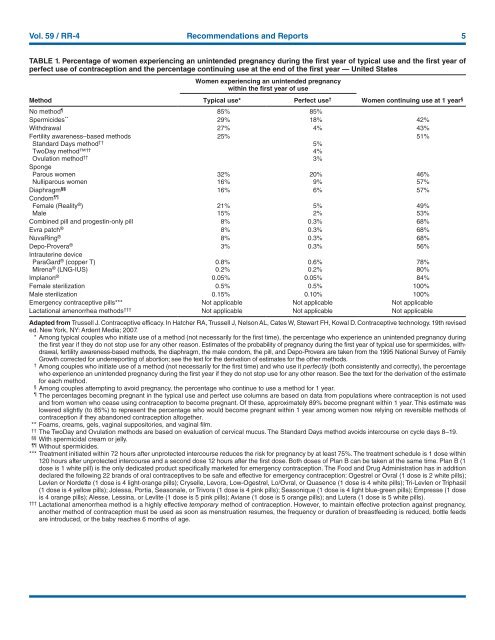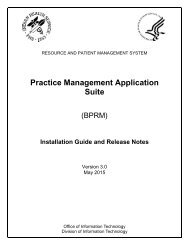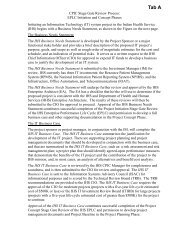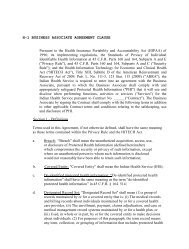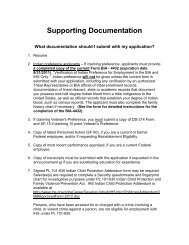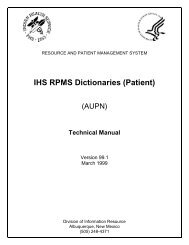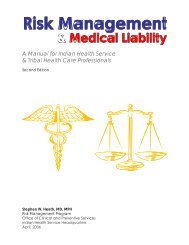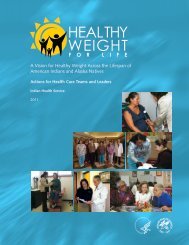CDC Article-US Medical Eligibility Criteria for Contraceptive Use, 2010
CDC Article-US Medical Eligibility Criteria for Contraceptive Use, 2010
CDC Article-US Medical Eligibility Criteria for Contraceptive Use, 2010
You also want an ePaper? Increase the reach of your titles
YUMPU automatically turns print PDFs into web optimized ePapers that Google loves.
Vol. 59 / RR-4 Recommendations and Reports 5<br />
TABLE 1. Percentage of women experiencing an unintended pregnancy during the first year of typical use and the first year of<br />
perfect use of contraception and the percentage continuing use at the end of the first year — United States<br />
Method<br />
Women experiencing an unintended pregnancy<br />
within the first year of use<br />
Typical use* Perfect use †<br />
Women continuing use at 1 year §<br />
No method 85% 85%<br />
Spermicides ** 29% 18% 42%<br />
Withdrawal 27% 4% 43%<br />
Fertility awareness–based methods 25% 51%<br />
Standard Days method †† 5%<br />
TwoDay method †† 4%<br />
Ovulation method †† 3%<br />
Sponge<br />
Parous women 32% 20% 46%<br />
Nulliparous women 16% 9% 57%<br />
Diaphragm §§ 16% 6% 57%<br />
Condom <br />
Female (Reality ® ) 21% 5% 49%<br />
Male 15% 2% 53%<br />
Combined pill and progestin-only pill 8% 0.3% 68%<br />
Evra patch ® 8% 0.3% 68%<br />
NuvaRing ® 8% 0.3% 68%<br />
Depo-Provera ® 3% 0.3% 56%<br />
Intrauterine device<br />
ParaGard ® (copper T) 0.8% 0.6% 78%<br />
Mirena ® (LNG-I<strong>US</strong>) 0.2% 0.2% 80%<br />
Implanon ® 0.05% 0.05% 84%<br />
Female sterilization 0.5% 0.5% 100%<br />
Male sterilization 0.15% 0.10% 100%<br />
Emergency contraceptive pills*** Not applicable Not applicable Not applicable<br />
Lactational amenorrhea methods ††† Not applicable Not applicable Not applicable<br />
Adapted from Trussell J. <strong>Contraceptive</strong> efficacy. In Hatcher RA, Trussell J, Nelson AL, Cates W, Stewart FH, Kowal D. <strong>Contraceptive</strong> technology. 19th revised<br />
ed. New York, NY: Ardent Media; 2007.<br />
* Among typical couples who initiate use of a method (not necessarily <strong>for</strong> the first time), the percentage who experience an unintended pregnancy during<br />
the first year if they do not stop use <strong>for</strong> any other reason. Estimates of the probability of pregnancy during the first year of typical use <strong>for</strong> spermicides, withdrawal,<br />
fertility awareness-based methods, the diaphragm, the male condom, the pill, and Depo-Provera are taken from the 1995 National Survey of Family<br />
Growth corrected <strong>for</strong> underreporting of abortion; see the text <strong>for</strong> the derivation of estimates <strong>for</strong> the other methods.<br />
†<br />
Among couples who initiate use of a method (not necessarily <strong>for</strong> the first time) and who use it perfectly (both consistently and correctly), the percentage<br />
who experience an unintended pregnancy during the first year if they do not stop use <strong>for</strong> any other reason. See the text <strong>for</strong> the derivation of the estimate<br />
<strong>for</strong> each method.<br />
§<br />
Among couples attempting to avoid pregnancy, the percentage who continue to use a method <strong>for</strong> 1 year.<br />
<br />
The percentages becoming pregnant in the typical use and perfect use columns are based on data from populations where contraception is not used<br />
and from women who cease using contraception to become pregnant. Of these, approximately 89% become pregnant within 1 year. This estimate was<br />
lowered slightly (to 85%) to represent the percentage who would become pregnant within 1 year among women now relying on reversible methods of<br />
contraception if they abandoned contraception altogether.<br />
** Foams, creams, gels, vaginal suppositories, and vaginal film.<br />
††<br />
The TwoDay and Ovulation methods are based on evaluation of cervical mucus. The Standard Days method avoids intercourse on cycle days 8–19.<br />
§§<br />
With spermicidal cream or jelly.<br />
<br />
Without spermicides.<br />
*** Treatment initiated within 72 hours after unprotected intercourse reduces the risk <strong>for</strong> pregnancy by at least 75%. The treatment schedule is 1 dose within<br />
120 hours after unprotected intercourse and a second dose 12 hours after the first dose. Both doses of Plan B can be taken at the same time. Plan B (1<br />
dose is 1 white pill) is the only dedicated product specifically marketed <strong>for</strong> emergency contraception. The Food and Drug Administration has in addition<br />
declared the following 22 brands of oral contraceptives to be safe and effective <strong>for</strong> emergency contraception: Ogestrel or Ovral (1 dose is 2 white pills);<br />
Levlen or Nordette (1 dose is 4 light-orange pills); Cryselle, Levora, Low-Ogestrel, Lo/Ovral, or Quasence (1 dose is 4 white pills); Tri-Levlen or Triphasil<br />
(1 dose is 4 yellow pills); Jolessa, Portia, Seasonale, or Trivora (1 dose is 4 pink pills); Seasonique (1 dose is 4 light blue-green pills); Empresse (1 dose<br />
is 4 orange pills); Alesse, Lessina, or Levlite (1 dose is 5 pink pills); Aviane (1 dose is 5 orange pills); and Lutera (1 dose is 5 white pills).<br />
†††<br />
Lactational amenorrhea method is a highly effective temporary method of contraception. However, to maintain effective protection against pregnancy,<br />
another method of contraception must be used as soon as menstruation resumes, the frequency or duration of breastfeeding is reduced, bottle feeds<br />
are introduced, or the baby reaches 6 months of age.


